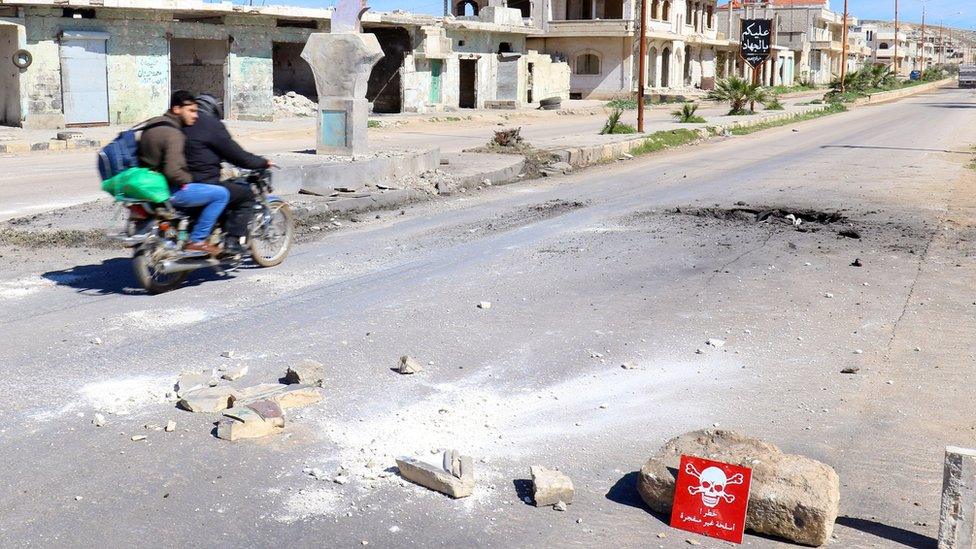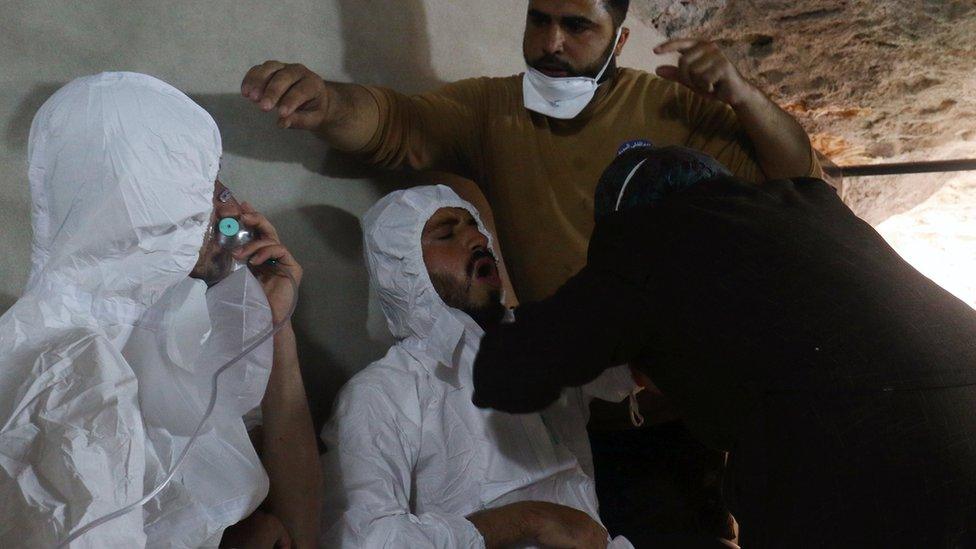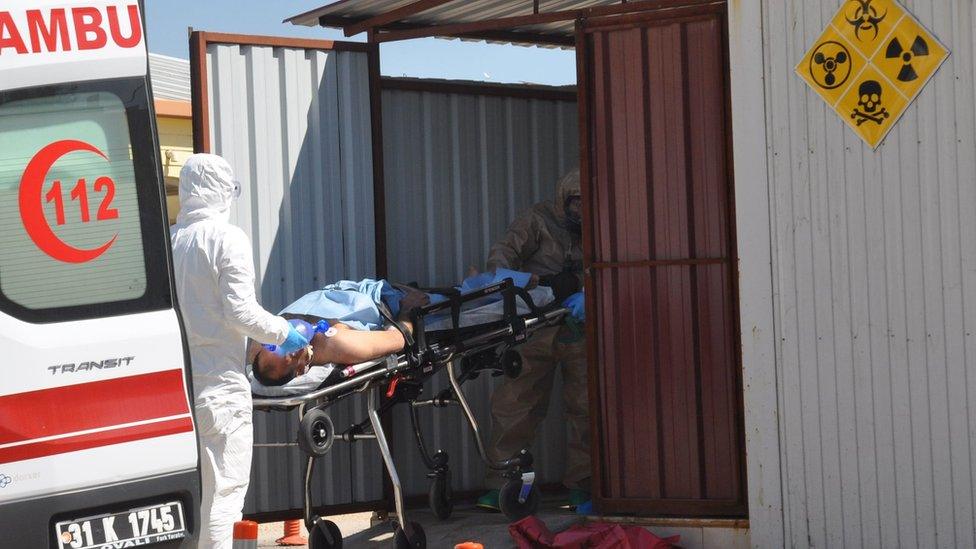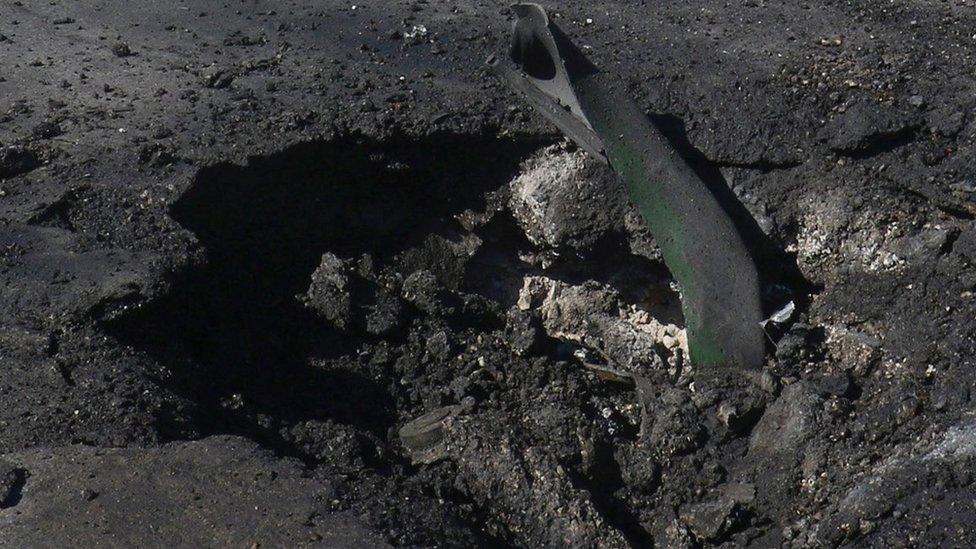Syria 'chemical attack': What can forensics tell us?
- Published

UN experts found rockets filled with Sarin were fired at rebel-held suburbs of Damascus in 2013
The recent incident involving chemical weapons in Syria demands an investigation. But from a technical perspective, what kind of forensic information can be gleaned from an incident like this?
Finding evidence that connects the chemicals to the weapon system and the victims is critical to establishing a narrative that explains what happened in Idlib province.
Chemical warfare forensics is heavily affected by the persistency or lack thereof of the chemicals involved.
The nerve agents all degrade in the environment, both by evaporation and by contact with moisture or other chemicals.
Sarin evaporates quite quickly, usually faster than water.
Tabun, an older nerve agent, and Soman, a somewhat more expensive nerve agent, both evaporate slower than Sarin.
VX is highly persistent, and evaporates extremely slowly.

A joint fact-finding mission has been launched by the UN and the Organisation for the Prohibition of Chemical Weapons
However, droplets get trapped in material and all of the nerve agents decompose into chemicals that are quite specifically related to them.
For example, isopropyl methylphosphonic acid, external (IMPA) is a specific indicator of Sarin.
When trying to detect nerve agents, there are several things to look for when analysing samples in a lab: traces of the nerve agents themselves, their logical degradation products, external (the chemicals that the nerve agents turn into when they age or decompose), unused precursors, by-products and impurities left over from the manufacturing process, and likely additives.
Most nerve agents are made with one or more additives, and these can be illustrative.

Russia says chemicals were released when an air strike hit a rebel ammunition depot
A good investigation will look for these traces in medical evidence, in the environment, and in the remnants of whatever device or weapon system was alleged to have been used.
Medical evidence can come in numerous forms.
Hair and clothing samples, for example, could contain useful chemicals. More importantly, there are several kinds of laboratory tests that can analyse blood samples from victims.
Levels of acetylcholinesterase, the enzyme in the human nervous system that nerve agents attach to, can establish that someone may have been exposed to nerve agents in general.
The presence of specific nerve agent decomposition products in the blood, such as IMPA, can give both generic and specific identifications of nerve agent exposure.
Another technique known as fluoride reactivation, external can identify specific nerve agents in blood samples, sometimes weeks after exposure.

Turkey says tests carried out on victims have confirmed that chemical weapons were used
Environmental samples from near the impact site are extremely useful. Soil samples could contain the agent, or any of the other chemicals of interest.
Samples of wastewater used for decontaminating victims could also contain valuable clues, while porous materials, particularly ones in confined spaces or out of direct contact with sunlight, may prove useful receptacles of chemicals of interest.
In the deadly Sarin attack on the Ghouta region outside Damascus in August 2013, items like a headscarf and a rubber window seal were crucial bits of evidence.

Opposition activists said this was a crater caused by an air strike in Khan Sheikhoun
Finally, much can be learned from the fragments and residue of the weapon system itself, whether it be a rocket, shell, or improvised barrel bomb.
The size, shape, and method of dissemination (for example, explosive bursting) can give clues to how the incident happened.
Air-dropped bombs, for example, narrow the suspects to those with aircraft.
Most importantly, the presence of a chemical warfare agent on any component or fragment of a weapon, as well as degradation products, by-products, and additives, can tie the whole narrative together, linking the chemical warfare agent with the weapon and possibly the perpetrator.
In 2013, the chemical hexamine, used as an additive, was a critical piece of information, external linking the Ghouta attack to the government of President Assad.
Dan Kaszeta is a London-based consultant. He is a former US Army Chemical Corps officer and has worked in chemical defence issues for over 25 years, including assignments at the White House Military Office and the US Secret Service. Follow him on Twitter, external.